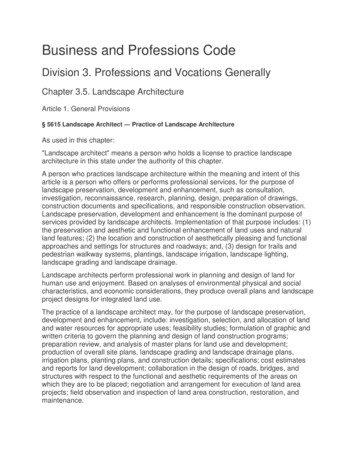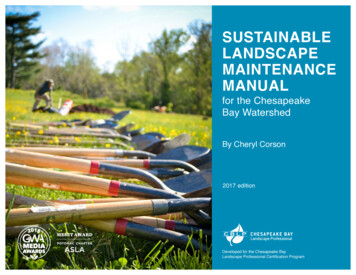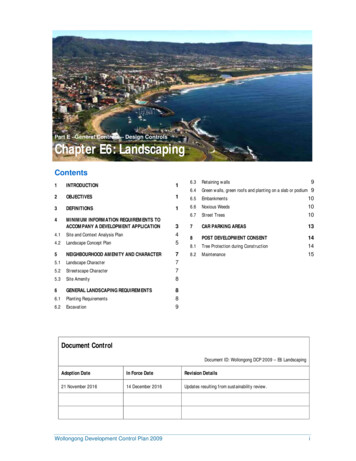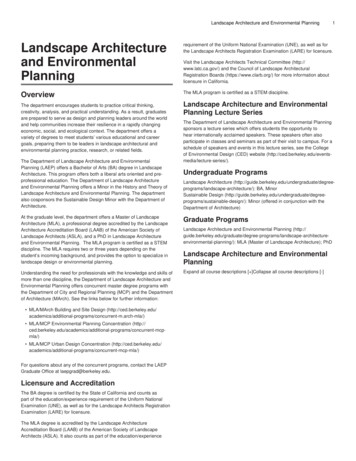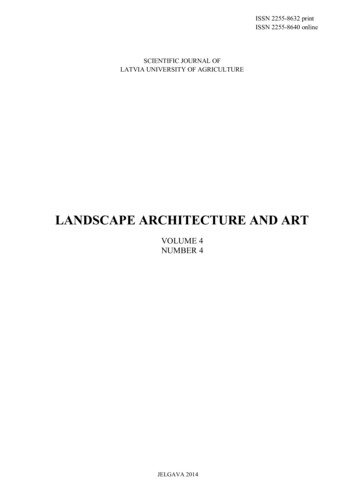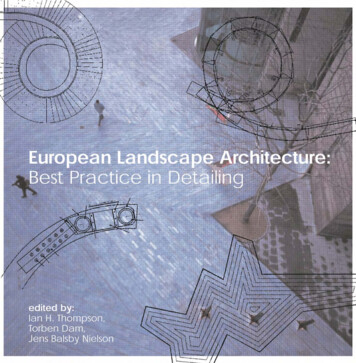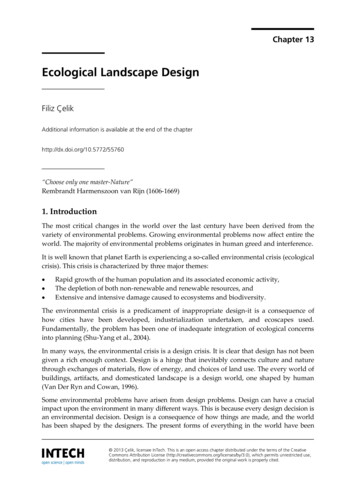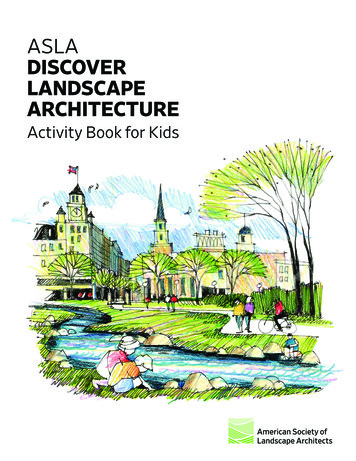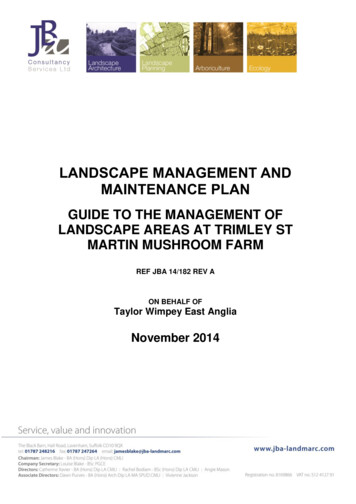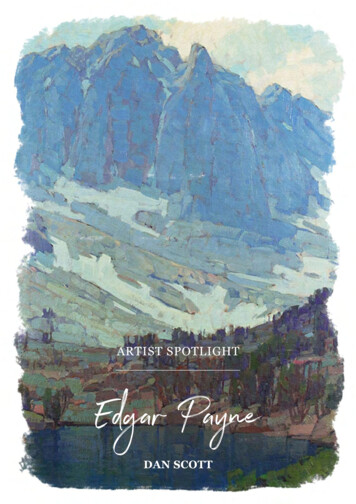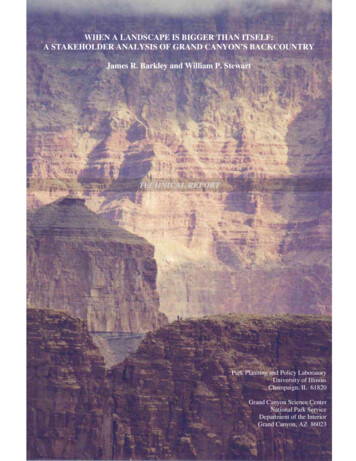
Transcription
WHEN A LANDSCAPE IS BIGGER THAN ITSELF:A STAKEHOLDER ANALYSIS OF GRAND CANYON’S BACKCOUNTRYJames R. Barkley and William P. StewartTECHNICAL REPORTPark Planning and Policy LaboratoryUniversity of IllinoisChampaign, IL 61820Grand Canyon Science CenterNational Park ServiceDepartment of the InteriorGrand Canyon, AZ 86023
EXECUTIVE SUMMARYGrand Canyon National Park has a diversity of stakeholders that care about itsbackcountry and know parts of it well. These stakeholders value the backcountry for avariety of reasons. Their values for the park’s backcountry are suggested in stories they tellof past trips, of places they visited, and memories of their experiences there. By asking themto recall places and situations of their backcountry travels, they enhance our capacity tounderstand their values for Grand Canyon.The purpose of this study is to further understand stakeholders through an assessmentof their place meanings. This report characterizes place meanings and values as told byvarious stakeholders, and done within contexts of conversations about pictures they took ofplaces on their backcountry trips. Specifically, the objectives of this study are:1.To identify stakeholder meanings of special places in the backcountry,2.To understand stakeholder values for Grand Canyon’s backcountry, and3.To share their place meanings and backcountry values with otherstakeholders.Fourteen stakeholders were issued a disposable camera and asked to take pictures ofplaces in Grand Canyon’s backcountry that are important to them. Conversations were heldwith stakeholders after their pictures were developed, and used as the centerpiece fordialogue. This method, referred to as photo-elicitation, has been applied effectively in manyresearch contexts that involve sensitive issues, highly-charged emotions, or hard-to-definemeanings. Both the photographs and text of interviews served as data for analysis. After theinterviews were transcribed into text, stakeholders were asked to review the interviewtranscripts to check its ability to represent their view. In all cases, phone interviews wereheld to insure reliability and trustworthiness of the data and research process. All text andphotographs in this report have been reviewed several times by each stakeholder to insure itsability to represent the viewpoint of the stakeholder and their respective organization.A narrative analysis is provided here that focuses on participants’ stories of theirexperiences in the backcountry. The participants in this study were all recognized asmembers of a larger organization. The narrative analysis starts with the mission of theorganization of each respective stakeholder, and the photographs and interview transcriptsare used to further explain and bring-to-life the mission statement. The narrative of eachstakeholder concludes by highlighting the backcountry values emerging from thecombination of mission statement and transcripts. The selected stakeholders represented thefollowing organizations: air tour operators, Arizona Wilderness Coalition/Grand CanyonWildlands Council, Sierra Club, Grand Canyon Hikers and Backpackers Association,Arizona State Horsemen’s Association, Four Seasons Guides, Grand Canyon Field Institutestaff, Director of the Grand Canyon Field Institute, the Grand Canyon Association, the NPSTrail Crew, the NPS Grand Canyon Science Center, the NPS Canyon District Rangers,1
Canyon Trail Rides, the NPS North Rim Backcountry office and Preventative Search andRescue rangers.Each stakeholder had a distinct approach to their meanings of places in thebackcountry. These approaches were often related to their purposes in the backcountry andthe mission of their respective organizations. The values and place meanings attributed toany given backcountry locale could be characterized as complex and multi-layered.The first conclusion recognizes the potential for convergence of values among thestakeholders of the park. The place meanings of the stakeholders represented in this reportspanned a wide spectrum of backcountry values. They appreciated the backcountry innumerous ways that aligned with the park’s own sense of itself. Both the GeneralManagement Plan (1995) and the Backcountry Management Plan (1988) identify the visionand goals for the park. These stated goals align with many of the place meanings and valuesof the stakeholders in this study. Recognizing overlap of values among stakeholders does notdiminish the potential for conflict or disagreement. Nonetheless a convergence of valuessuggests a larger context for any given point of conflict, and would surround anydisagreement as an exception to an otherwise broad set of values that converge to guide parkmanagement.The second conclusion suggests that the park continue developing its dialogue withstakeholders including the further development of working relationships. The park alreadyhas a history of dialogue with most of its stakeholders, and working relationships withseveral. Such dialogue and relationships are built, as well as diminished, by issues of trustand respect for each other. The General Management Plan (1995) and the First AnnualCentennial Strategy for Grand Canyon National Park (2007) assert a commitment for thedevelopment of working relationships between the park and its stakeholders. Fortunately,backcountry management and planning have a long history of constructive dialogue withstakeholders and mutually beneficial working relationships. The park should continuestrengthening the connections already in place with its stakeholders.The strength of this report lies in its ability to reflect an array of stakeholdervalues (albeit incomplete) for public sharing, dialogue, and learning from oneanother. By building upon its strong foundation of stakeholder relations, GrandCanyon National Park and its partners will increase their effectiveness in achievingtheir goals.2
TABLE OF CONTENTSINTRODUCTION. 7METHODS . 8PARTICIPANTS: FOURTEEN STAKEHOLDERS . 9FINDINGS . 12THE ARIZONA STATE HORSEMEN’S ASSOCIATION: JEAN . 12GRAND CANYON FIELD INSTITUTE: MIKE. 17GRAND CANYON FIELD INSTITUTE: NICK . 21GRAND CANYON ASSOCIATION: WILLIAM . 26GRAND CANYON NATIONAL PARK SCIENCE CENTER: DAVE . 31SIERRA CLUB: ERIC. 38GRAND CANYON HELICOPTERS: LINDA . 45FOUR SEASONS GUIDES: KATIE . 48ARIZONA WILDERNESS COALITION/GRAND CANYON WILDLANDS COUNCIL: KIM . 55NPS TRAIL CREW: PATRICK . 58CANYON TRAIL RIDES: KITTY. 65NPS CANYON DISTRICT RANGERS: OSCAR . 72NPS NORTH RIM BACKCOUNTRY OFFICE: GARY. 79GRAND CANYON HIKERS AND BACKPACKERS ASSOCIATION: NORMAN . 85DISCUSSION . 93APPRECIATION OF BACKCOUNTRY PLACES . 93TEACHING, LEARNING, AND SHARING THE CANYON . 93FEELINGS OF AWE . 94PERSONALIZED HISTORY OF SPECIFIC PLACES . 943
WORKING THE CANYON. 95CONCLUSIONS . 96CONVERGENCE OF VALUES . 96WORKING RELATIONSHIPS WITH STAKEHOLDERS. 97REFERENCES. 99APPENDICES . 101APPENDIX A:WRITTEN INSTRUCTIONS FOR RESEARCH PARTICIPANTS . 102APPENDIX B:RESEARCH MATERIALS . 1044
LIST OF PHOTOGRAPHSFigure 1: ‘the old Teddy Roosevelt horse camp’. 12Figure 2: ‘ingenuity’ . 13Figure 3: ‘1920’s ranger uniform’ . 14Figure 4: ‘hard work’ . 15Figure 5: ‘intergeneration experience’. 15Figure 6: ‘relaxing and enjoying a poignant moment’. 17Figure 7: ‘everyone needs to relax sometime’. 18Figure 8: ‘individualized learning experience’ . 19Figure 9: ‘a history of overlapping civilizations’ . 20Figure 10: ‘backcountry narrows’. 21Figure 11: ‘esplanade sandstone and the ecosystem’ . 22Figure 12: ‘a classic grand canyon sight’ . 23Figure 13: ‘rocks as historic human tools: a bi-face point’ . 24Figure 14: ‘rocks as historic human tools: a roasting feature’. 25Figure 15: ‘plants in really odd places – out of a rock wall’ . 27Figure 16: ‘plants in really odd places – beautiful and deadly’. 28Figure 17: ‘people in really odd places – Phantom Ranch’ . 29Figure 18: ‘people in really odd places – two bridges in the wilderness’. 30Figure 19: ‘sharing in the Grand Canyon experience’. 32Figure 20: ‘experiencing the artifacts of human history’. 33Figure 21: ‘a rare agave plant; an agricultural artifact’ . 34Figure 22: ‘following historic footsteps through the backcountry’ . 35Figure 23: ‘a fun little scramble’ . 36Figure 24: ‘taken to the top by curiosity’. 37Figure 25: ‘see and feel the contrast’. 39Figure 26: ‘contrast of survival; life in an unlivable place’. 40Figure 27: ‘wildflowers without footprints’ . 41Figure 28: ‘ephemeral footprints in the sands of the backcountry’ . 42Figure 29: ‘natural architecture of the backcountry’ . 43Figure 30: ‘first sight - the oldest exposed rock on earth’ . 45Figure 31: ‘three hundred million years of climate change, and a mystery’ . 46Figure 32: ‘one billion years of earth’s history; a geologic snapshot’. 47Figure 33: ‘backcountry toilet’ . 49Figure 34: ‘backcountry cook stand’ . 50Figure 35: ‘the kitchen sink’ . 51Figure 36: ‘positive mental attitude’. 52Figure 37: ‘an ideal [quick] introduction to the backcountry’. 53Figure 38: ‘summer sunrise on the way to work’ . 59Figure 39: ‘morning commute in the wintertime’. 60Figure 40: ‘working the canyon’s rocks - connecting with American history’ . 61Figure 41: ‘wintertime break room below the snowline’. 62Figure 42: ‘marking the change of seasons’ . 63Figure 43: ‘summer sunset’ . 64Figure 44: ‘sunrise solitude at the corral’ . 655
Figure 45:Figure 46:Figure 47:Figure 48:Figure 49:Figure 50:Figure 51:Figure 52:Figure 53:Figure 54:Figure 55:Figure 56:Figure 57:Figure 58:Figure 59:Figure 60:Figure 61:Figure 62:Figure 63:‘discovering plant life along the trail’ . 66‘Supai tunnel – portal to a whole new world’ . 67‘unique conditions and resilient plants’. 68‘riding a mule - fifteen years of ears’ . 69‘spectacular paint job - the look and feel of erosion’ . 70‘framing the canyon – symbolizing the backcountry experience’ . 71‘relaxing at Nankoweap – effort for solitude, landscape change, and big sky’ . 72‘Clear Creek – naiveté, social interaction, and Cathy the Turkey’ . 74‘Bright Angel Creek meets the Colorado River: a social environment’ . 77‘backcountry rescue – not a typical Super Bowl Sunday’. 78‘local stories and human history’ . 79‘marks of prehistoric human effort’ . 80‘hiking through geology on a trail to water’. 81‘living in the backcountry’ . 82‘relaxing and eating on a backcountry visit’ . 83‘Parashant Canyon - looking down at the heart of Grand Canyon’ . 85‘Basalt cliffs - small people in a big place’ . 88‘backcountry transience - people as shadows on the land’ . 90‘backcountry napping’. 916
INTRODUCTIONGrand Canyon National Park has a diversity of stakeholders that care about itsbackcountry and know parts of it well. These stakeholders value the backcountry for avariety of reasons. Their values for the park’s backcountry are suggested in stories they tellof past trips, of places they visited, and memories of their experiences there. By asking themto recall places and situations of their backcountry travels, they enhance our capacity tounderstand their values for Grand Canyon. Be it spiritual renewal, learning about oneself,working to protect the park’s heritage, or scouting a new route, to know the values ofstakeholders is to know their meanings of places and backcountry trips they hold dear.The purpose of this study is to further understand stakeholders through an assessmentof their place meanings. Such information provides the park with contexts in whichstakeholders create, maintain, and assert their values for the backcountry. Rather than a usezone, a trail, or a designated campsite, the locales of the backcountry are filled with meaningby stakeholders and become relevant to the mission of their organizations. It is thesemeanings that transform the backcountry from spaces to places (Proshansky et al., 1983;Puddifoot, 1996). A traditional forum to learn of stakeholder values is in public hearings orworkshops removed from the backcountry and potentially adversarial in tone. Sometimes atthese public forums stakeholders find themselves telling what should be done rather than whya place is valued. This report characterizes place meanings and values as told by variousstakeholders, and done within contexts of conversations about pictures they took of places ontheir backcountry trips.Specifically, the objectives of this study are:1.To identify stakeholder meanings of special places in the backcountry,2.To understand stakeholder values for Grand Canyon’s backcountry, and3.To share their place meanings and backcountry values with otherstakeholders.7
METHODSLandscape values and place meanings are challenging to articulate (Kruger &Shannon, 2000). Several researchers have developed strategies to identify place meaningsand values by asking participants to discuss their experiences in a place (Brandenburg &Carroll, 1995; Cheng, Kruger, & Daniels, 2003). Sometimes called the “lived experience,”landscape values are embedded in the re-living and re-telling of experiences of one’sbackcountry trip. Place meanings, although characterizing a locale, provide values thatconnect oneself to other places, people, and society. For example, in his analysis of specialplaces of Michigan’s Black River, Schroeder (1996) asked participants to tell about theirfavorite places along the Black River. In their depiction several participants’ meanings werecentered on its unique features to teach outdoor skills to their sons and daughters. He (andhis participants) interpreted these stories in ways that explained the qualities of the BlackRiver that functioned for this purpose and were highly valued. Other researchers have usephotographs or other prompts to elicit stakeholder landscape values (Harper, 2002; Stewart,Leibert, Larkin, 2003).To facilitate the identification of backcountry values at Grand Canyon, selectedstakeholders were issued a disposable camera and asked to take pictures of places in GrandCanyon’s backcountry that are important to them. Conversations were held withstakeholders after their pictures were developed, and used as the centerpiece for dialogue.Most stakeholders have numerous places in the backcountry that hold special meaning tothem. However it was not necessary to capture an exhaustive collection of special places.The photographic documentation is instrumental in evoking a discussion about the meaningsof special places, and used as a prompt for a general set of values for the backcountry. Thismethod, referred to as photo-elicitation, has been applied effectively in many researchcontexts that involve sensitive issues, highly-charged emotions, or hard-to-define meanings(Harrison, 2002; Halbwachs, 1992; Banks, 2001).Both the photographs and text of interviews served as data for analysis (Clark, 1999).After the interviews were transcribed into text, stakeholders were asked to review theinterview transcripts to check its ability to represent their view. In all cases, at least onefollow-up phone interview was held to insure reliability and trustworthiness of the data andresearch process. The photographs and texts presented herein have each gone through aniterative process with their respective stakeholders.We anticipated some stakeholders may not be comfortable capturing their specialplaces with photographic imagery, and alternate options for characterizing meaning of placeswere explored in a few cases. In addition, we were sensitive that some stakeholders wouldnot want to identify, or have us make public, their respective place meanings. All text andphotographs in this report has been reviewed several times by each stakeholder to insure itsability to represent the viewpoint of the stakeholder and their respective organization.Participants in this study were issued 27-exposure Kodak Easy Flash One-TimeUse cameras. Participants were also given written instructions to take pictures of‘important places’ in the backcountry at Grand Canyon (see Appendix A). After either8
taking pictures with the camera and/or choosing existing photos from past visits to thebackcountry, the participants sat down with James Barkley of the University of Illinois todiscuss their photographs. The conversations were recorded using both digital and analog(i.e., magnetic audio-tape) handheld recording devices simultaneously. The analog recordingdevice used was a Sony TCM-200DV Handheld Cassette Voice Recorder. The digitalrecording device used was an Olympus W-10 Handheld Digital Voice Recorder. With apreference for the analog format due to superior sound quality, the audio recordings wereuploaded into the ‘the free, cross-platform sound editor,’ Audacity (available online at:http://audacity.sourceforge.net/) and converted to MP3 format. The MP3 files were thentranscribed, and analyzed, by James Barkley at the Park Planning and Policy Laboratory.See appendix A for an image of the camera and recording equipment used in this study.A narrative analysis is provided here that focuses on participants stories of theirexperiences in the backcountry. The participants in this study were all recognized asmembers of larger stakeholder organizations. The narrative analysis starts with the missionof the organization of each respective stakeholder, and the photographs and interviewtranscripts are used to further explain and bring-to-life the mission statement. The narrativeof each stakeholder concludes by highlighting the backcountry values emerging from thecombination of mission statement and transcripts.Participants: Fourteen stakeholdersParticipants in this study were selected after careful deliberation. It was not possibleto include all stakeholders of the park’s backcountry in this study. During a visit to the parkin 2003, the authors and NPS staff identified a list of about 60 organizations consideredstakeholders by the park’s backcountry work group. To streamline this list to a feasiblenumber to include as participants in this study, the following criteria were developed. Thecriteria for prioritizing stakeholders for inclusion in the study were: (1) The stakeholderorganization has a history of an active relationship with the park’s backcountry managementissues. (2) The stakeholder organization will likely be represented in any upcoming reviewsand comment periods of the backcountry management plan. (3) The stakeholder organizationhas a primary focus that cares about the park’s backcountry.During summer 2004, James Barkley resided in Flagstaff to become acquainted witha number of stakeholders, introduced the study, and sought their interest in participating in it.This on-the-ground experience provided a first-hand sense of the geographic context for parkplanning and insight regarding the strengths and limitations of the research approach.Fourteen stakeholders were invited and able to finish their role as a participant in this study.The 14 participants are characterized below using pseudonyms.“Linda” represents the air tour operators and has been flying helicopters over GrandCanyon for two summers. The owner of an air tour company and his general manager choseLinda to represent their group’s interest in this study.9
“Kim” represents the Arizona Wilderness Coalition/Grand Canyon WildlandsCouncil. Kim has worked in and/or lived at Grand Canyon for approximately 35 years, andwill likely represent himself and the group in any upcoming review of the backcountrymanagement plan.“Eric” represents the Sierra Club and has been hiking the backcountry at GrandCanyon for more than 30 years. Although Eric’s group will be represented in any upcomingreview of the backcountry management plan, Eric does not anticipate himself being activelyinvolved in that representation.“Norman” represents the Grand Canyon Hikers and Backpackers Association, andhas been hiking in Grand Canyon for more than 35 years, beginning as a young boy.Norman will likely represent himself and the group in the upcoming review of thebackcountry management plan.“Jean” represents the Arizona State Horsemen’s Association and has been makingannual trips to Grand Canyon with other members for approximately 7 years to ride theArizona Trail. Both Jean and another member of the ASHA were recommended by NPSstaff as potential study participants. The second ASHA member recommended Jean, and shewill likely represent the interests of the ASHA in any upcoming review of the backcountrymanagement plan.“Katie” represents the Four Seasons Guides, and did her first overnight backpack inGrand Canyon at age 10, more than 15 years ago, and has spent several summers in the parkas a commercial backpacking working out of a Flagstaff base office. Katie was chosen bythe commercial use permit holder represent himself, the outfitting, and the guiding business.Katie will not likely be representing her group in the upcoming planning process. The ownerof the business was initially contacted and chose Katie to represent the group’s interests inthis study.“Nick” represents the instructors of the Grand Canyon Field Institute (GCFI). Nickhas been working and backpacking in Grand Canyon for approximately 12 years. The GCFIinstructors will likely defer group representation to a superior in the upcoming review of thebackcountry management plan.“Mike” represents the Director of the Grand Canyon Field Institute. Mike has beenliving, working, and backpacking in GCNP for approximately 12 years. Mike will likelyrepresent GCFI’s interests in any upcoming review of the backcountry management plan.“William” represents the Grand Canyon Association (GCA) and began backpackingin the backcountry within the last couple of years when he first moved to the area to work forthe GCA. William was a recommendation from staff at the GCFI as someone who shouldparticipate in the study due to the nature of the GCA and its mission that is closely tied to thepark’s backcountry areas. William will represent the GCA in any upcoming review of thebackcountry management plan.10
“Patrick” represents the staff from the NPS Trail Crew. Patrick has worked onbackcountry trails at Grand Canyon for 13 years. Patrick’s NPS supervisor was initiallycontacted and chose Patrick to represent the group’s interests in this study. The NPS TrailCrew will likely be represented by Patrick’s superior in any upcoming review of thebackcountry management plan.“Dave” represents staff from the Grand Canyon Science Center who are interested inthe backcountry. Dave has been backpacking in Grand Canyon for approximately 18 years;beginning as a pre-teen. Dave has served as a backpacking guide, a river guide/boatman, andwas recommended by one of his superiors in the Science Center. Dave will likely deferrepresentation of the Science Center to a superior in any upcoming review of the backcountrymanagement plan.“Oscar” represents staff from the Canyon District Rangers. Oscar has beenbackpacking in the Grand Canyon for approximately 16 years, and volunteered to participatein the study to reflect viewpoints of the backcountry rangers. Oscar has a history ofbackcountry search and rescue at Grand Canyon. Oscar will likely represent himself and theCanyon District rangers in any upcoming review of the backcountry management plan.“Kitty” represents Canyon Trail Rides (CTR) and has been a mule wrangler on theNorth Rim for approximately 16 years. The majority of her rides into the Canyon have beendown the North Kaibab Trail. Kitty was recommended by the CTR manager for participationin this study.“Gary” represents the staff from the North Rim Backcountry office and PreventativeSearch and Rescue rangers. Gary has been living in northern Arizona and working as aseasonal employee on the north rim for approximately 6 years. Gary began backpacking inGrand Canyon around the same time he
University of Illinois Champaign, IL 61820 Grand Canyon Science Center National Park Service Department of the Interior Grand Canyon, AZ 86023 TECHNICAL REPORT . EXECUTIVE SUMMARY Grand Canyon National Park has a diversity of stakeholders that care about its backcountry and know parts of it well. These stakeholders value the backcountry for a
